TRIDENT ISSUE
7201_JWC_May2016_Magazine_ORIG_Low
7201_JWC_May2016_Magazine_ORIG_Low
Create successful ePaper yourself
Turn your PDF publications into a flip-book with our unique Google optimized e-Paper software.
inspiring voices<br />
A Farewell to JWC and Norway<br />
by Brigadier General Roger H. Watkins<br />
AS I REFLECT OVER the<br />
past two years here at the<br />
Joint Warfare Centre, I am<br />
struck by three significant<br />
perspectives: the extraordinary<br />
quality of personnel<br />
and output in this headquarters, the resiliency<br />
of such a diverse collection of military and civilian<br />
professionals, and how fortunate we are<br />
to be located in Norway. I'll explain in slightly<br />
more detail what I mean.<br />
When I arrived at the headquarters in<br />
early July 2014, JWC was in the midst of one of<br />
the largest turnovers experienced to date, some<br />
41 per cent of the staff had either changed or<br />
would change over the course of the summer,<br />
including the Chief Joint Exercise Division, the<br />
Director of Management, myself, and somewhat<br />
unexpectedly, the Commander. Furthermore,<br />
a decision had been taken to develop an<br />
implementation plan for the restructuring, or,<br />
optimization of the headquarters' organization.<br />
Finally, the Programme of Work for the<br />
2014-2015 "exercise year" (September through<br />
June) was scheduled to be the busiest in the<br />
history of JWC. Despite all of these seemingly<br />
enormous challenges, JWC delivered five major<br />
exercises, including hosting two different<br />
Training Audiences here in Stavanger in backto-back<br />
fashion, with over 800 personnel during<br />
each rotation. The results were superb, and<br />
the feedback received indicated that the JWC<br />
was truly having a positive effect on the preparation<br />
of the NATO Response Force (NRF)<br />
readiness and certification process.<br />
Simultaneously, a small team worked<br />
under tremendous time and resource constraints<br />
to develop the implementation plan<br />
for the new trial optimized headquarters<br />
structure. Included in this massive effort was<br />
a full two-day "war-game" of the JWC's trial<br />
organization against the 2016 Programme of<br />
Work to ensure the new structure could cope<br />
appropriately. Additionally, after receiving approval<br />
from the Supreme Allied Commander<br />
Transformation (SACT), approval was sought<br />
and received from the NATO Defence Manpower<br />
Committee to conduct the trial.<br />
All the while the JWC was developing<br />
and planning what would become NATO's<br />
largest exercise since the Cold War, <strong>TRIDENT</strong><br />
JUNCTURE 2015. The ability to accomplish all<br />
of this in just one calendar year was absolutely<br />
remarkable and I still look back in amazement<br />
at how this tremendous team came together to<br />
accomplish everything in such quality fashion!<br />
Anytime an organization is made of<br />
a diverse group of individuals, the potential<br />
exists for tension, if not conflict, to manifest<br />
itself. The JWC currently encompasses personnel<br />
from 15 NATO Member Nations as well as<br />
one Partnership for Peace (PfP) Nation. Our<br />
staff has military personnel, NATO civilians<br />
and contractors—all who come together to deliver<br />
the extraordinary work I described above.<br />
How has this been accomplished?<br />
I firmly believe that JWC's "One Team"<br />
culture has as much to do with our success<br />
as any other single factor. I still recall during<br />
►►►<br />
16 The Three Swords Magazine 30/2016



